I love nighttime photography. There is such a sense of magic in capturing a scene despite the lack of visible light. In this walk-through, I will show you how I created this photo with a long exposure and flash. It’s really pretty simple, and a lot of fun, so give it a go yourself!
What you’ll need
- Camera with a long lens (I use my Canon EOS 7D Mk II and my Tamron 70-200mm f/2.8)
- Two tripods (I used an SLR Gorillapod for my camera to support it on the slope, and a Vanguard, extended as tall as I could make it, for the main flash)
- Two flashes (I used a Canon Speedlight 580EX II for the main flash and a Canon Speedlight 430EX II for the in-hand flash.
- Off-camera radio trigger system for each flash (I used my Godox system, with an X1T transmitter on the camera and an X1R receiver on each flash)
- Camera remote (I used the Canon RC-6 remote)
- A white bed sheet
- A helpful friend who’s willing to wrap a bed sheet around herself in a field, at night, in winter*
*Winter optional. Also, it’s Australian winter, so I’m not even asking that much, really.
Setting up the scene
My goal was to capture my model, Falon, with the night sky behind her. I found a hillside that had the look I needed: High enough to have nothing visible behind it, as long as I got the camera down low.
I set my camera up with a long lens on a low tripod, down the hillside from where Falon stood. The first flash was set up on a tall tripod higher up the hill so that the camera, Falon and flash made a triangle. Falon held the second flash, after getting dressed in her stylish bed sheet outfit. Both flashes were bare (meaning no diffusers or modifiers).
I used a Godox receiver on each flash and a transmitter unit on top of my camera to set off the flashes remotely. The newer Canon flashes have radio transmitters built-in, but mine doesn’t, so I needed the extra kit.
Once we were ready to shoot, I laid on the grass behind her, trying to be like Harry Potter at Dudley’s birthday party.
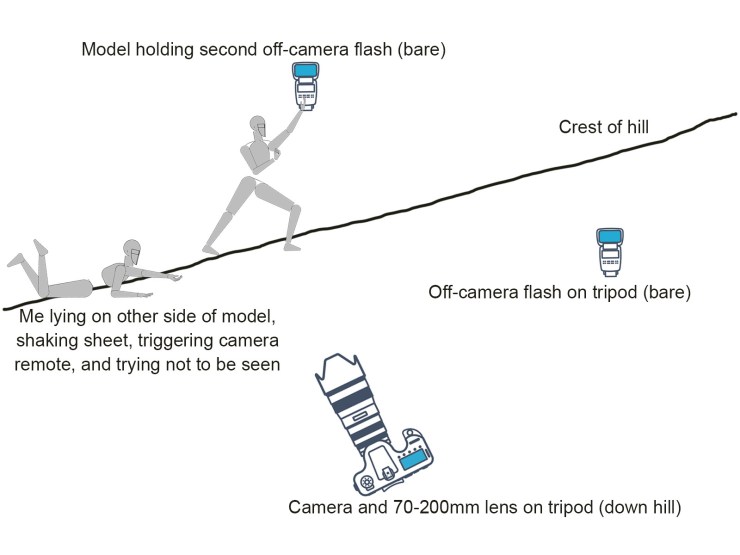
Camera settings to use for long exposure with flash
To get your settings right for this, it’s important to understand the lighting logic. First, I wanted the background to show the stars. Therefore, my camera settings needed to expose for the starry sky.
I made sure my camera was on manual, and experimented with shutter speeds, ISO and aperture until the sky was exposed to my liking. Then I chose ISO 1000, a shutter speed of 15 seconds and set the aperture to f/6.3 to make sure Falon was in focus.
I also set the lens to manual focus: I shone a torch on Falon so my autofocus could see her and bring the lens into focus, then switched it to manual so it wouldn’t try to refocus on her for every shot.
Flash settings for long exposure
Second, Falon would be “stamped” onto the photo by the burst of rear curtain flash at the end of the exposure. Therefore, the output from both flashes needed to expose her properly. Again, I experimented with test shots and found I was happy with the main flash (in manual mode) set to about half power and the second hand-held flash on quarter power.
The power needed depends on the distance from the camera and your exposure settings, so just have a play with it. Instead of experimenting, you could get it exactly right with a light meter, but I didn’t have one, so I tweaked the main flash until things looked right, then added the second flash.
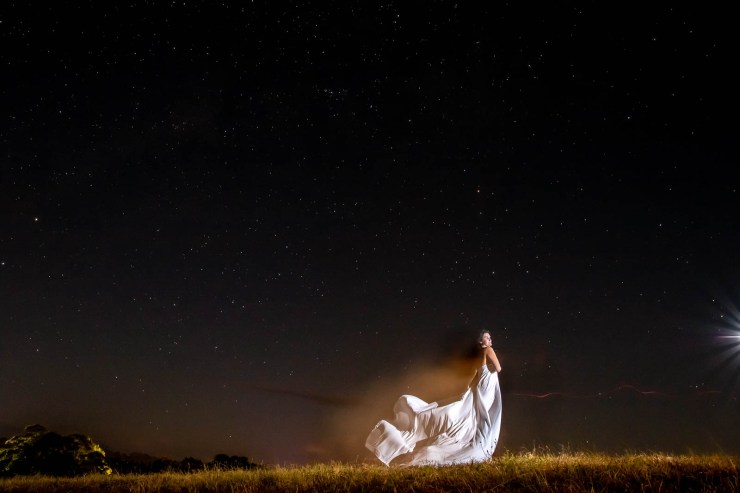
Rear-curtain sync
Using rear-curtain sync is critical, so don’t forget to set it. Rear-curtain sync means the flash fires just before the shutter closes, instead of when the shutter first opens. To be honest, I always have my flashes set to fire on the rear curtain. It’s great for low light situations like wedding receptions: Set the camera to 1/40 second exposure, flash on TTL (auto) and fire on the rear curtain, and you’ll capture a beautiful atmospheric glow from the room as well as people clearly and sharply exposed with the flash.
Treating each part of the photo separately is key to a successful long exposure with a flash photo. The background is exposed by the camera settings, and the foreground subject is exposed by the flash. It’s like taking two photos in one.
If all this talk of flash is both confusing and exciting to you, I can thoroughly recommend the CreativeLive class, “Speedlights 101” with Mark Wallace. It was a game-changer for me.
How to get the shot
Once everything was ready, I laid on the ground behind Falon, with my camera remote in hand. I hit the trigger, started counting out the fifteen seconds, and shook her bedsheet dress up and down to give the impression it was billowing in the wind. Falon held her position, the flashes fired, and I threw a blanket at Falon (did I mention it was winter?) before scurrying down the hillside to check what we got.
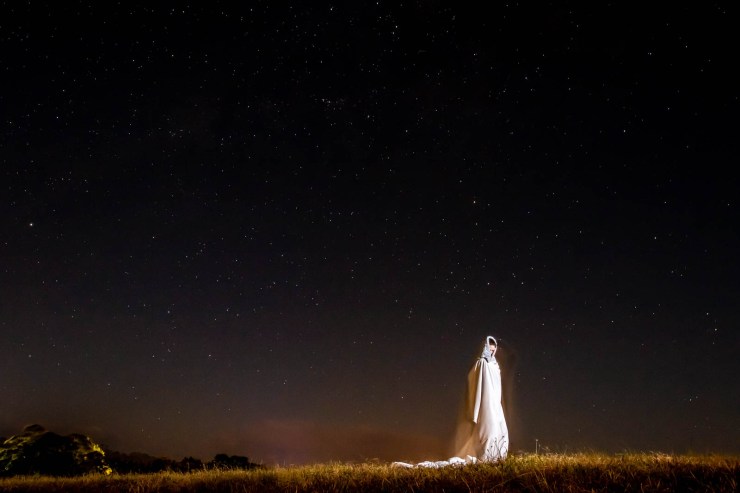
It took us two hours, 93 photos, a lot of bloopers and at least one accidental selfie, to get two photos that I was thrilled with.
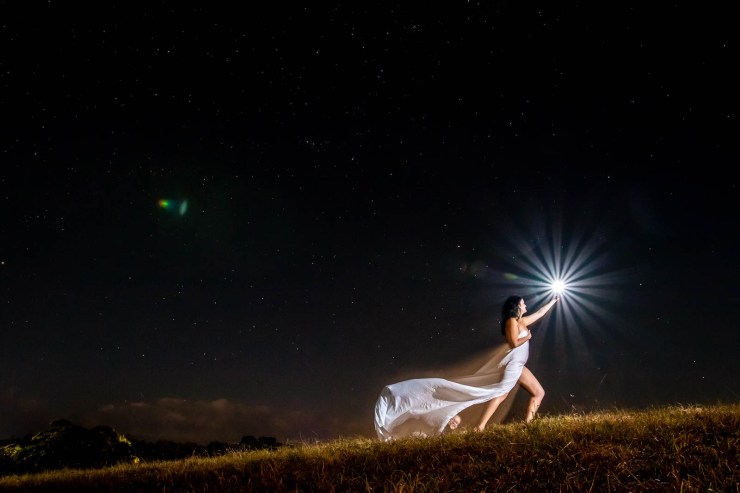
These two were my favorites from the set. The first I like because she looks like she’s dashing away into the night, and the second because she looks like an ancient Roman goddess.
.mgl-tiles { display: none; } #mgl-gallery-634ece99a2a8a { margin: -5px; width: calc(100% + 10px); } #mgl-gallery-634ece99a2a8a .mgl-box { padding: 5px; } @media screen and (max-width: 768px) { #mgl-gallery-634ece99a2a8a { margin: -5px; width: calc(100% + 10px); } #mgl-gallery-634ece99a2a8a .mgl-box { padding: 5px; } } @media screen and (max-width: 460px) { #mgl-gallery-634ece99a2a8a { margin: -5px; width: calc(100% + 10px); } #mgl-gallery-634ece99a2a8a .mgl-box { padding: 5px; } }
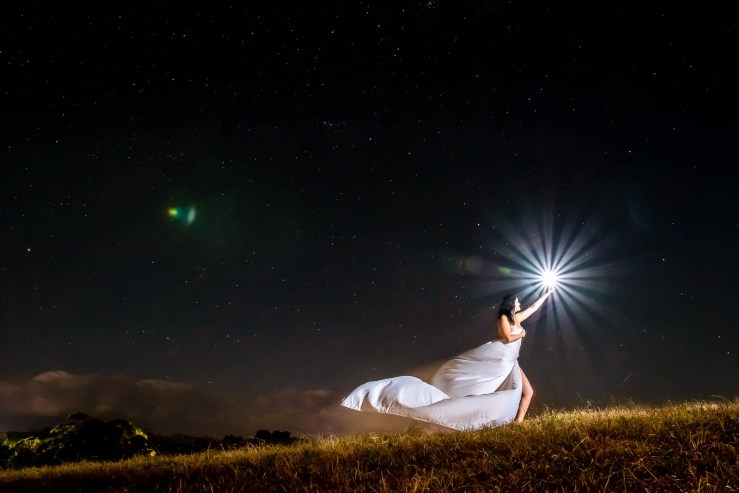
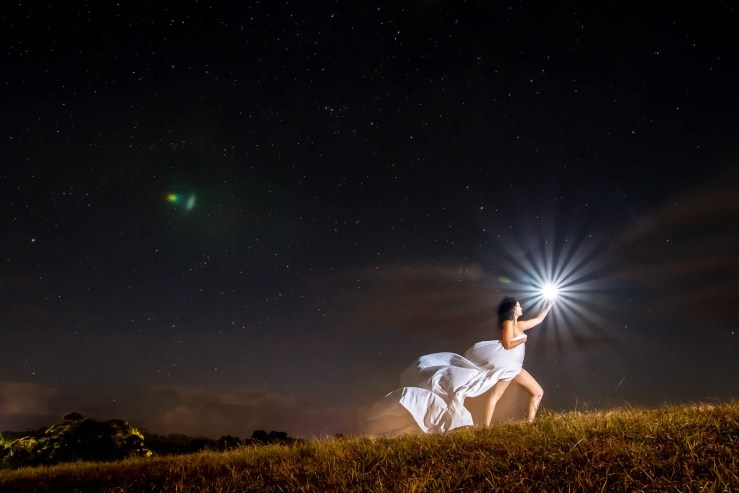
You can see in all the photos there is an orange haze around the bottom of the sheet. That’s the light from nearby streetlights reflecting off the sheet during the 15-second exposure. Although Falon is being “stamped” in by the rear curtain flash, there was still enough ambient light to expose her a little, so she had to stay motionless for the whole 15 seconds. I liked the golden glow around her, but to get a really clean exposure, you could find a darker field where the only light source is your flashes.
With some basic flash equipment and a bit of experimentation, it’s easy to create a unique night portrait.
Tell your story with the second annual Visual Storytelling Conference!
Experience four days of interactive, online training sessions featuring a range of educational content with experienced photographers and content creators. This free event kicks off with a series of technical boot camps to build essential skills, followed by live, online sessions on photography, video, business and social media. Join live from March 10-13, 2022!
